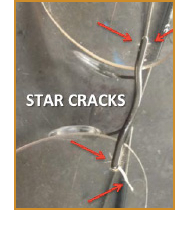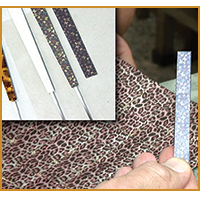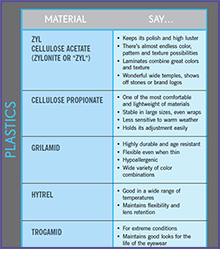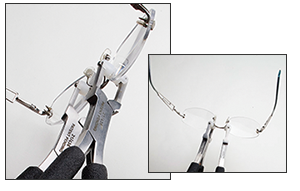|
Your monthly guide to staff training outside the box
Eyes / Lenses / Fitting Lenses / Free-Form / Frames / Sunwear / Patient Solutions / In-office / Standards
FRAMES, Materials and Handling
Issues—Rimless Frame Construction/Materials

By Mark Mattison-Shupnick, ABOM
For some mounting systems, lenses loosen easily and need to be tightened or renewed. In fact, once lenses begin to loosen, tightening is required more often until renewal is required. In a screw/nut rimless frame, the nut may be over-tightened, compressing the lens more, leading to a faster loosening and exploitation of any micro-cracks at the entrance or exit of the drill hole. This loosening is a problem especially for rimless since most U.S. consumers own one pair of current Rx glasses. Combined with the fact that many offices are less experienced in adjusting rimless and many cannot disassemble and reassemble a frame when renewal of lenses, screws or bushings are required, the frame needs to be sent to the laboratory for renewal and repair. Patients can be left without their primary eyeglasses for up to a week.
Like all consumer products, not all rimless frames are made the same. Some use better materials, different kinds and qualities of titanium, or some hold their adjustment better than others. The choice of screw and nut, cap nut or bushing quality also changes how effective the frame is at holding lenses tight or facilitating adjustment or renewal.
See Plus »
|
|


|
Have Your Glasses Adjusted Frequently
By Mark Mattison-Shupnick, ABOM, and Keith M. Cross, ABOC
Encourage children to return with eyewear periodically (for instance, every six months) to check on how well their eyewear is performing. Is it being cared for, and if not does it need to be readjusted? Even if frames don't need to be readjusted and the eyewear is performing well, a visit such as this may reinforce compliance with care instructions. Be sure to tell patients to come back for frame adjustments whenever needed. A well-adjusted pair of glasses also lasts longer. For new prescriptions, have them come back in about eight weeks to readjust the glasses, as learning to use them and understanding what's comfortable may take
a little time.
See Plus »
|
Plastic Handmade Frames
|
By Mike Hundert and Nicolas Roseillier
 Plastic handmade frames (not injection molded) can vary greatly by design. Materials are cut into rectangular pieces about the height and width of the frame front. Modern factories have invested highly in the past decade to automate the milling steps. While traditionally each cut of plastic meant moving the frame from one machine to another, today's computer assisted "CNC" machines feature multiple cutting blades that are directed to make specific cuts and bevels, including the eyewire groove, before spitting it out and grabbing a new piece of material.
Plastic handmade frames (not injection molded) can vary greatly by design. Materials are cut into rectangular pieces about the height and width of the frame front. Modern factories have invested highly in the past decade to automate the milling steps. While traditionally each cut of plastic meant moving the frame from one machine to another, today's computer assisted "CNC" machines feature multiple cutting blades that are directed to make specific cuts and bevels, including the eyewire groove, before spitting it out and grabbing a new piece of material.
Multiple layer acetate provides infinite opportunities to cut and reveal various layers and
colors. Tumbling for days amidst polishing agents and materials brings out the material's shine, which is then finished by hand polishing. Too much polishing can wear through the frame, destroying it. Meanwhile, temples are shaped and then "shot" with a wire core. Temple ornaments or plaques are attached in a variety of ways, including imbedding them into the plastic.
See Plus »
|
|
�Nursing Homes and Thin Skinned
By Zoriana N. Mangione
|
Even if the frame is generally a good fit, there are several considerations that affect frame comfort for the nursing home population. Mature skin is extremely thin and lacks the fatty deposits in the bridge area that was once more abundant. This means that the bridge of the nose has a greater tendency to get painful red marks from bent or poorly adjusted nosepads. One would be amazed at how quickly the red marks turn into open sores or cystic formations, which can sometimes even cause blocked tear ducts. Changing smaller, hard plastic or vinyl nosepads to the soft silicone variety, in the 15 to 17 mm size range, are an important first step in
remedying the situation. Next, the optician should pay careful attention to adjusting the nosepad angles so that they closely match the contours of the wearer's bridge.
See Plus »
|

Quick Reference - Frame Materials
|
|
|
Adding Face Form:
3-Piece Rimless

Two pliers are used to make the face form bridge adjustment (below). Brace where the hardware passes through the lenses (this removes the stress on the lens when the bridge is adjusted). Use the double nylon jaw gripping pliers to angle the bridge so the curve is more "inward" or as needed. The adjustment should be made on both sides of the bridge. Use two pliers to align lenses.
See Plus »
|
|